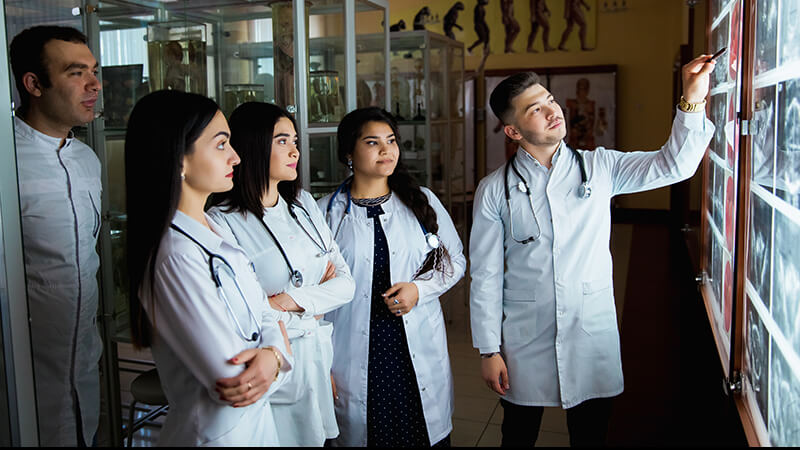
Practice Perfect 727
Teaching on the Job
Teaching on the Job

One of the challenges of being a podiatrist and working with students and residents is running a busy clinic while providing quality teaching experiences. I’ll admit to anyone who asks that this is an area of teaching with which I have a hard time. My educational clinic at the WesternU Health Foot and Ankle Center in Pomona, CA usually has from 20-30 patients in a half day, with pathology running the gamut from nail fungus to reconstructive surgery (your typically general podiatrist’s clinic). For most individual podiatrists, this is not terribly busy, but when you add in trainees with varying levels of experience, this number of patients can be difficult to complete.
A few of the challenges are:
- Allowing students enough time to interview patients.
- Realizing that each patient encounter is actually two encounters (one by the student and one by the attending).
- Understand that students are much slower than attendings for a variety of reasons, mostly due to lack of experience.
- Maintaining high quality patient care.
- Running the clinic on time and minimizing patient wait times.
- Giving students appropriate and useful feedback on their performance.
The challenge of teaching students in clinic involves the balancing of several competing interests
As I’m sure you can see from this list, there are several competing interests, all of which conflict during a relatively short time period. This can create a stressful experience for many attendings. As a result, each of us must understand our limitations and take every opportunity to educate our students. As I mentioned, I’m still working on this, which was one of the reasons I greatly enjoyed the Faculty Development Workshop at this year’s PRESENT Podiatric Residency Education Virtual Summit. If you missed it, then join us next year.
I learned a lot of useful information at the workshop, but I’d like to highlight one intriguing clinical teaching pearl presented by Dr Suhad Hadi, a resident educator in her own right: the one-minute preceptor.
What is the One-Minute Preceptor?
This is a clinical teaching model that consists of five “microskills” that is meant to act as a framework to efficiently teach while maintaining clinic flow.1 The microskills are:
- Get a Commitment from the Trainee - The trainee should be pushed to make a diagnosis and formulate a treatment plan. This forces them to process the clinical information. If they can do this then they have demonstrated their holistic understanding of the patient’s history, physical, and disease process. Failure to do this reveals a deficiency in the trainee’s thought process or knowledge, opening up a teaching opportunity. An example of a cue to getting a commitment would be, “What do you think is going on with this patient?” Resist the urge to tell them the diagnosis to speed up the conversation.
- Probe for Supporting Evidence - This microskill is essentially the trainee describing his or her support for the stated diagnosis. For example, you might ask, “What aspects of your history and physical support that diagnosis?” Be sure to let the trainee think out loud a bit and use what they say to you to cue you in on other questions to ask to guide erroneous thinking. Let’s say the trainee is stating their erroneously supporting evidence for a patient with heel pain by describing painful medial heel palpation but missing a positive Tinel’s sign. You might then ask if Tinel’s sign supports plantar fasciitis or tarsal tunnel syndrome.
- Teach General Rules - This is the point where the actual teaching begins. However, the creators of this method are quick to point out that if nothing incorrect was stated then this step should be skipped. In the example started in step 2, teaching the general rule might look something like, “Tinel’s sign is generally more indicative of a neurological cause of heel pain like tarsal tunnel syndrome rather than plantar fasciitis.”
- Reinforce What was Done Right - Pointing out the correct aspects is an excellent first step to providing feedback. Make sure the feedback is focused and specific. For instance, pointing out that the trainee did a “good job” is too nonspecific to be useful. Instead, you might congratulate the student on a thorough history before moving on to a discussion about errors or mistakes.
- Correct Mistakes - This final step allows the attending to explain errors and correct thought process issues. Again, it is important to be specific but also concise, keeping in mind that this entire process shouldn’t take more than a few minutes. Additionally, avoid judgmental statements and stick with objective criticism.
This method has been shown to be an effective teaching tool in a systematic review and is preferred by both trainees and preceptors alike.2 Take a little time to practice this skill; I suggest taking one or two microskills and inserting them into your next clinical teaching situation rather than trying the entire method at once. After a few practice sessions you’ll have an easy time working the full one-minute preceptor into your clinical education.

-
Neher JO, Gordon KC, Meyer B, Stevens N. A five-step “microskills” model of clinical teaching. J Am Board Fam Pract. Jul-Aug 1992;5(4):419-424.
Follow this link -
Gatewood E, De Gagne JC. The one-minute preceptor model: A systematic review. J Am Assoc Nurse Pract. 2019 Jan;31(1):46-57.
Follow this link




























Comments
There are 0 comments for this article